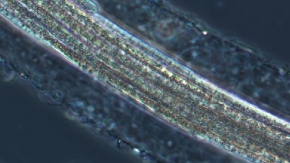Research Highlights
Ecophysiology of Thioploca ingrica as revealed by the complete genome sequence supplemented with proteomic evidence

Large sulfur-oxidizing bacteria, which accumulate a high concentration of nitrate, are important constituents of aquatic sediment ecosystems. No representative of this group has been isolated in pure culture, and only fragmented draft genome sequences are available for these microorganisms. In this study, we successfully reconstituted the genome of Thioploca ingrica from metagenomic sequences, thereby generating the first complete genome sequence from this group. The Thioploca samples for the metagenomic analysis were obtained from a freshwater lake in Japan. A PCR-free paired-end library was constructed from the DNA extracted from the samples and was sequenced on the Illumina MiSeq platform. By closing gaps within and between the scaffolds, we obtained a circular chromosome and a plasmid-like element. The reconstituted chromosome was 4.8 Mbp in length with a 41.2% GC content. A sulfur oxidation pathway identical to that suggested for the closest relatives of Thioploca was deduced from the reconstituted genome. A full set of genes required for respiratory nitrate reduction to dinitrogen gas was also identified. We further performed a proteomic analysis of the Thioploca sample and detected many enzymes/proteins involved in sulfur oxidation, nitrate respiration and inorganic carbon fixation as major components of the protein extracts from the sample, suggesting that these metabolic activities are strongly associated with the physiology of T. ingrica in lake sediment.
Reference
Journal: The ISME Journal
Title of original paper: :Ecophysiology of Thioploca ingrica as revealed by the complete genome sequence supplemented with proteomic evidence
Authors: Hisaya Kojima, Yoshitoshi Ogura, Nozomi Yamamoto, Tomoaki Togashi, Hiroshi Mori, Tomohiro Watanabe, Fumiko Nemoto, Ken Kurokawa, Tetsuya Hayashi and Manabu Fukui
DOI :10.1038/ismej.2014.209












